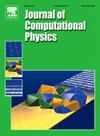非等温过滤问题:双温计算模型
IF 3.8
2区 物理与天体物理
Q2 COMPUTER SCIENCE, INTERDISCIPLINARY APPLICATIONS
引用次数: 0
摘要
本文提出了一种新的两相不可压缩流体非等温过滤的计算模型。从应用的角度来看,我们讨论的是当热水从注入井进入时,水取代油的问题。所提出模型的特殊性在于它的双温度公式。双温公式被理解为热非均质性,其中在考虑的区域的每个点上确定了两相流体和多孔块的温度,并指出了两个连续体之间的热相互作用。数学模型以一阶方程组的混合形式表示,包含四个标量函数(液体压力、水饱和度、液体和多孔介质温度)和三个矢量函数(液体总速度和液体和多孔介质的导热通量)。空间逼近是基于混合有限元和中心FVM相结合的方法。时间逼近采用带上旋的显隐格式。其中,过滤方程采用了impes型方法,能量方程根据CFL条件明确考虑了对流传递和时间步长的选择。对于流体和多孔介质之间的热交换,使用显式和隐式近似。结果表明,在质量守恒律和能量守恒律中,显式格式的稳定条件明显弱于CFL条件,其精度与隐式格式的精度一致。此外,双温度模型使研究液体中导热传递的作用成为可能。本文章由计算机程序翻译,如有差异,请以英文原文为准。
Non-isothermal filtration problem: Two-temperature computational model
The article proposes a new computational model of non-isothermal filtration of a two-phase incompressible fluid. From the point of view of applications, we are talking about the displacement of oil by water when hot water enters from an injection well. The specificity of the proposed model is its two-temperature formulation. The two-temperature formulation is understood as thermal heterogeneity, in which at each point of the domain under consideration the temperatures of the two-phase fluid and porous blocks are determined, and the thermal interaction between the two continua is indicated. The mathematical model is presented in a mixed formulation in the form of a system of first-order equations in terms of four scalar functions (liquid pressure, water saturation, liquid and porous medium temperatures) and three vector functions (total liquid velocity and heat conductive fluxes of the liquid and porous medium). The spatial approximation is based on a combination of mixed FEM and centered FVM. The time approximation consists of using an explicit-implicit scheme with upwinding. In particular, IMPES-type method is used for the filtration equations, and the energy equations explicitly consider convective transfer with the choice of time step according to the CFL condition. For heat exchange between the fluid and the porous medium, both explicit and implicit approximations are used. It is shown that the stability condition of the explicit scheme is significantly weaker than the CFL conditions for convective flows in the mass and energy conservation laws at an accuracy coinciding with the accuracy of the implicit scheme. Also, the two-temperature model made it possible to study the role of heat conductive transfer in a liquid.
求助全文
通过发布文献求助,成功后即可免费获取论文全文。
去求助
来源期刊

Journal of Computational Physics
物理-计算机:跨学科应用
CiteScore
7.60
自引率
14.60%
发文量
763
审稿时长
5.8 months
期刊介绍:
Journal of Computational Physics thoroughly treats the computational aspects of physical problems, presenting techniques for the numerical solution of mathematical equations arising in all areas of physics. The journal seeks to emphasize methods that cross disciplinary boundaries.
The Journal of Computational Physics also publishes short notes of 4 pages or less (including figures, tables, and references but excluding title pages). Letters to the Editor commenting on articles already published in this Journal will also be considered. Neither notes nor letters should have an abstract.
 求助内容:
求助内容: 应助结果提醒方式:
应助结果提醒方式:


